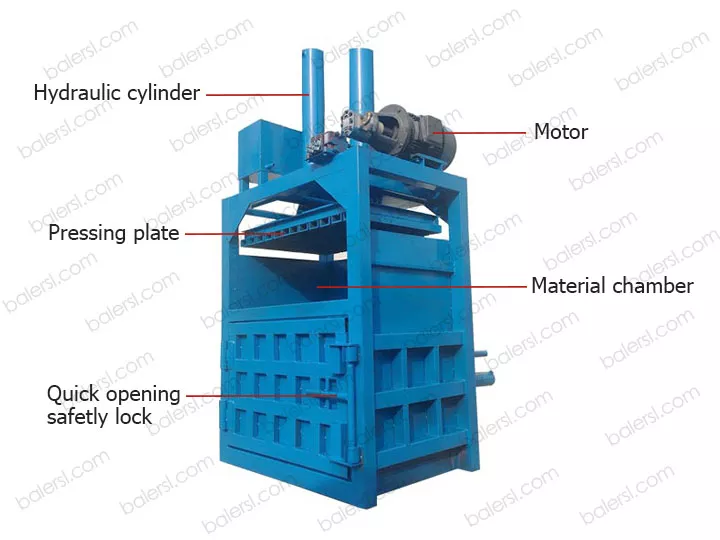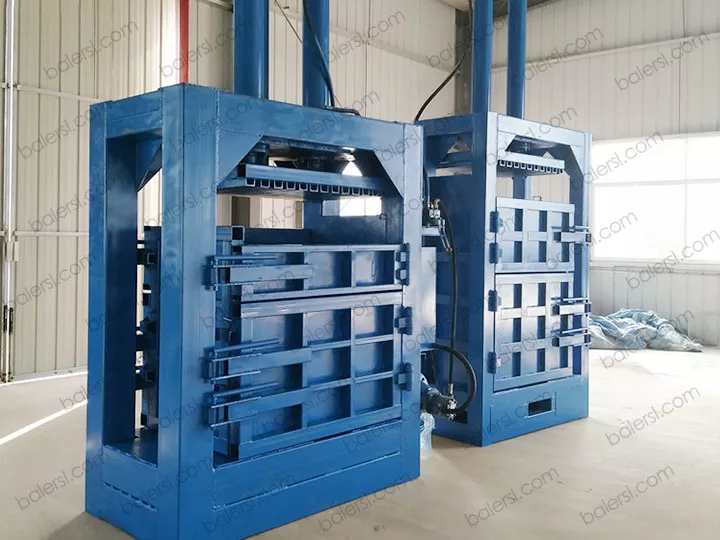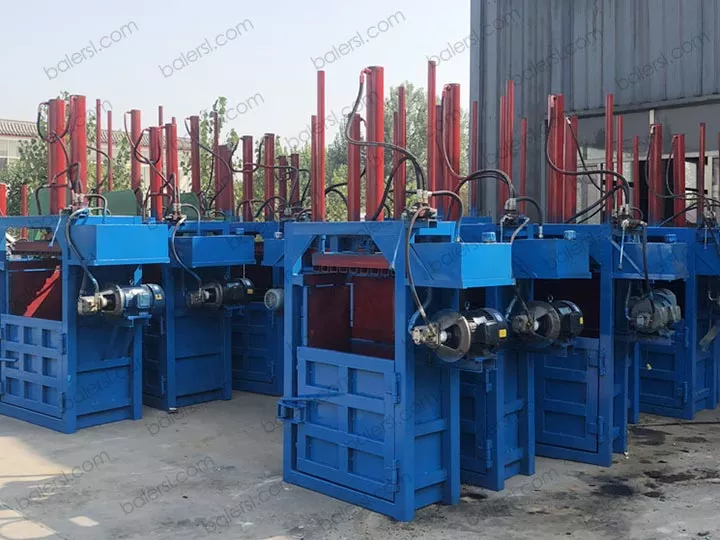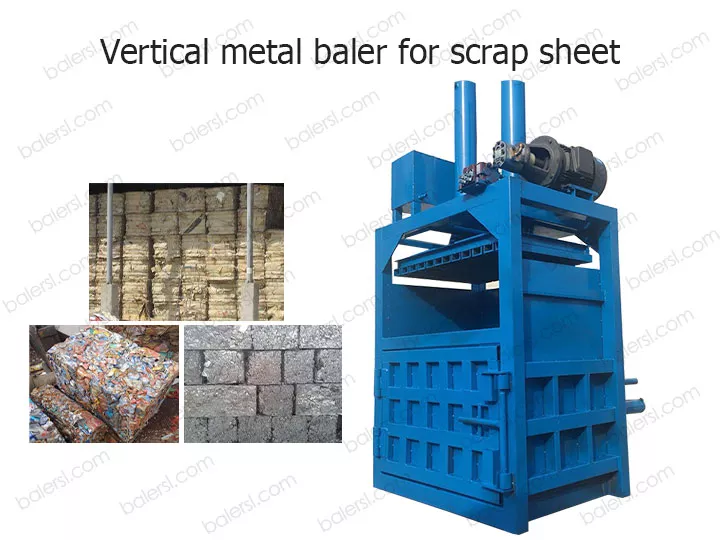油圧垂直金属ベーラーは、垂直下向きの力と圧力を加えて、さまざまな材料を圧縮します。段ボール、紙、繊維、缶、プラスチック、非鉄金属など、さまざまな品目を効果的に梱包できます。材料は密な長方形のブロックに冷間梱包されるため、保管と輸送が容易になります。
さまざまなタイプのベーラーの中で、垂直ベーラーは最もコスト効率が高く、施設内の占有スペースが最小で、操作が簡単で安全です。 24、30、36、48、60、72 インチのサイズのベールを製造できます。生産プロセスには、オペレーターが材料を積み込み、ピストンを動かし、ベールを結ぶ作業が含まれます。
油圧式金属ベーラーで処理できる材料は何ですか?
このベーラーはその多用途性が認められており、段ボール、新聞用紙、PET プラスチックボトル、HDPE プラスチック、アルミ缶、ブリキ缶、スチール缶、自動車スクラップ、製造用端材、建設廃材、シュリンク材など、さまざまな材料を管理できます。ラップ、プラスチックフィルム、布地、織物など。

垂直金属スクラップベーラーから恩恵を受けるのは誰ですか?
垂直油圧ベーラーは主に、さまざまな種類のばらけた材料、細かい材料、または廃棄物を圧縮して梱包するために設計されています。この装置は、古紙、プラスチック、金属スクラップ、繊維など、複数の業界にわたって広範な用途に使用されています。
主なユーザーには、大型小売店、キオスク、学校、倉庫、病院、薬局、流通センター、食料品店、ホームセンター、リサイクル業者、製造工場、非鉄スクラップ置き場、地方自治体のリサイクル施設、ショッピング プラザ、スーパーマーケット、ホテルなどがあります。

産業廃棄物の梱包・リサイクルのメリット
- コストの削減 – 廃棄費用を削減してお金を節約します。
- スペースを最適化する – 散らかりを減らし、つまずく危険を軽減します。
- 収益の増加 – 紙の俵を製紙工場に売ってお金を稼ぎます。
- エネルギーの節約と削減 – たとえば、アルミニウム製品をリサイクルすると、約 95% のエネルギーを節約できます。
スクラップ梱包機のコンポーネント
スクラップ梱包機は主に次のコンポーネントで構成されています。
- 油圧システム: 金属梱包プロセスで圧縮力を達成するために強力な圧力を提供します。
- フレームとホッパー: 金属材料を支持して固定し、梱包して圧縮できるようにします。
- 油圧シリンダーとピストン: 油圧でピストンをフレームに押し付けます。また、金属材料を圧縮して圧縮成形します。
- コントロールパネル: 垂直金属ベーラーの動作とパラメータ設定を制御し、圧力や梱包時間などのパラメータを調整するために使用されます。

縦型メタルコンパクターの動作原理
準備
リサイクル可能な品目はベーラーチャンバーに積み込まれ、安全かつ適切に配置されます。
ベーラーを開始します
制御パネルを通じて油圧システムが起動され、垂直金属ベーラーの油圧シリンダーとピストンが作動し始めます。
圧縮プロセス
油圧シリンダーがピストンを押し下げて圧力を加えます。油圧シリンダーの端にあるプラテンは、希望のベール サイズに達するまで材料を圧縮します。
梱包を終了する
事前に設定された梱包状態に達すると、油圧システムが動作を停止し、梱包が終了します。次に、ベールをワイヤーまたはストラップで結びます。
排出方法
縦型金属ベーラーは、要求に応じて、さまざまな排出方法で梱包された金属片を排出します。手動または自動放電モードを選択できます。
ベーラーから出てくるリサイクル可能なブロックのサイズと重量は、使用するベーラーのサイズによって異なります。
スクラップシートベーラーの排出方法
縦型スクラップベーラーにはさまざまな排出方法があり、顧客はニーズに応じて必要なモードを選択できます。
- 手動排出: オペレータはベールに包まれた金属ブロックをベーラーから手動で取り除きます。これは、より小規模な生産規模と作業スペースに適しています。
- 自動排出: 梱包された金属ブロックは自動搬送システムにより指定場所まで自動搬送されるため、大量生産や連続運転に適しています。

油圧板金ベーラーの利点
- 横型ベーラーと比較して、縦型スクラップ梱包機は占有スペースの点でよりコンパクトであり、限られたスペースに適しています。
- 高張力鋼板と油圧部品を使用しており、耐荷重性と耐久性に優れています。
- 需要に応じて、手動または自動の排出方法を選択でき、高い柔軟性があり、さまざまな作業環境に適応できます。
- 材料ボックスは回転式密閉蓋設計を採用しており、大きな開口面積を提供するため、大きな材料、空の材料、薄い材料の投入が特に容易になります。
- すべての可動コンポーネントは油圧を使用して動作するため、安定した性能、高い梱包圧力、確実な結束、効率的な梱包が保証されます。

縦型金属ベーラーの技術仕様
| モデル | SLV-15 | SLV-30 | SLV-60 | SLV-80 | SLV-120 |
| プレッシャー | 15T | 30T | 60T | 80T | 120T |
| 力 | 5.5-7.5KW | 5.5KW | 7.5KW | 11KW | 18.5KW |
| 容量 | 0.6-0.8T/H | 0.8-1T/H | 1.5-2T/H | 2-3T/H | 4-5T/H |
| ベール重量 | 20-40KG | 100KG | 300KG | 400-500KG | 400-600KG |
| ベールサイズ | 600*400*200-500mm | 800*400*600mm | 900*600*800mm | 1100*800*1000 mm | 1200*800*12 00mm |
| 機械 重さ | 1トン | 1.2トン | 1.5トン | 2トン | 3.2トン |
また、Shuliyは、顧客のさまざまなニーズに対応するために横型金属ベーラーも提供しています。私たちはリサイクルおよび廃棄物処理業界におけるトップの技術革新者です。リサイクル品に縦型ベーラーを購入していただければ、お客様のビジネスニーズに最適なベーラーの選択をお手伝いします。

